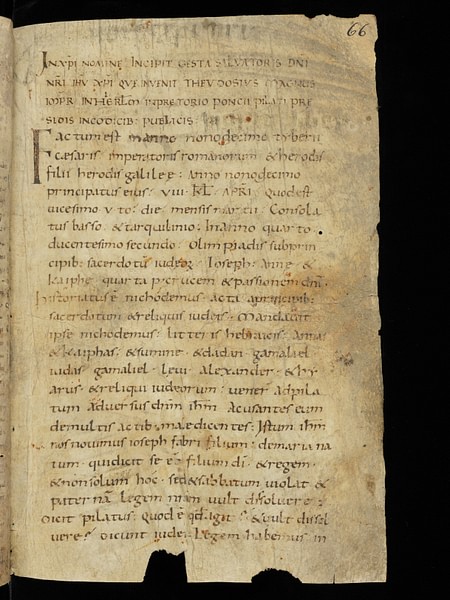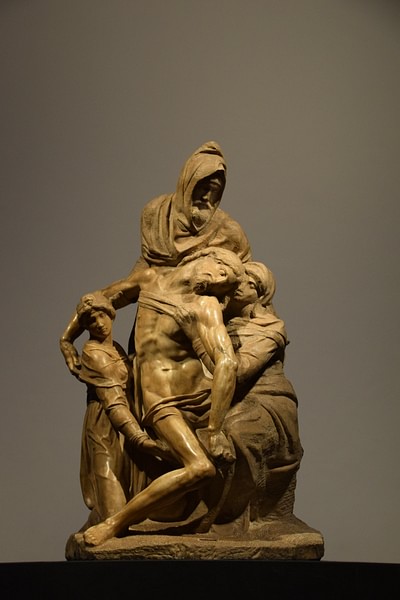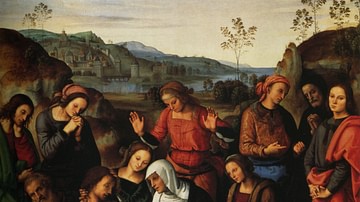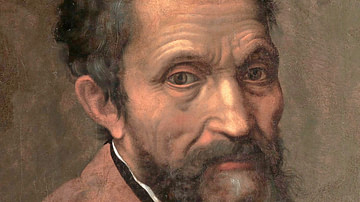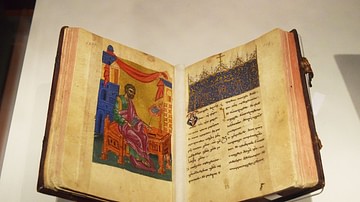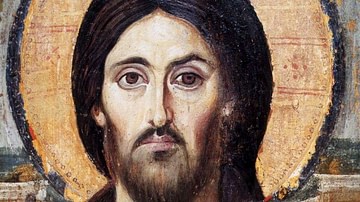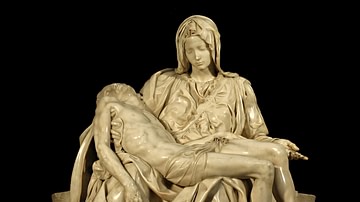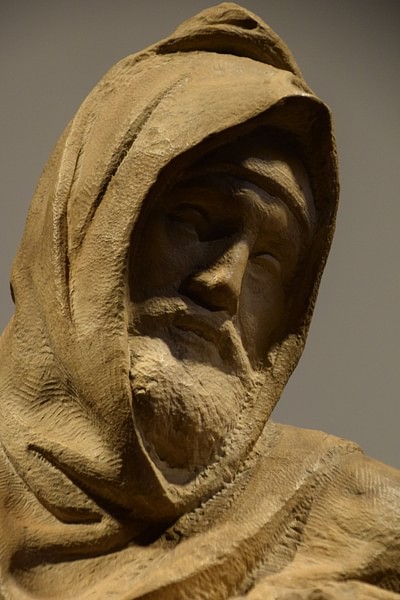
Nicodemus was an early follower of Jesus Christ, uniquely mentioned only in the fourth gospel, the Gospel of John. According to that gospel, he was a Pharisee and a member of the Sanhedrin (the Jewish Council) in Jerusalem at the time of the trial and crucifixion of Jesus of Nazareth.
The Gospel of John
In the Synoptic Gospels (Mark, Matthew, Luke), Jesus is born human but attained the vindication of the righteous through resurrection and was exalted to Heaven. The Gospel of John is unique because John's Jesus pre-existed and was present at creation as the logos ("word" or "rationality") who became flesh according to the Christian doctrine of Incarnation. John's Jesus consistently claimed that he is the only one who has seen the Father, for he is "the one and only Son, who came from the Father" (John 1:14). John's gospel utilized the literary devices of metaphor and allegory in the teachings of Jesus: "I am the bread of life" (John 6:48).
John's unique portrait of Jesus is summed up in the speech to Nicodemus:
Now there was a Pharisee, a man named Nicodemus who was a member of the Jewish ruling council. He came to Jesus at night and said, "Rabbi, we know that you are a teacher who has come from God. For no one could perform the signs you are doing if God were not with him." Jesus replied, "Very truly I tell you, no one can see the kingdom of God unless they are born again." "How can someone be born when they are old?" Nicodemus asked. "Surely they cannot enter a second time into their mother's womb to be born!" Jesus answered, "Very truly I tell you, no one can enter the kingdom of God unless they are born of water and the Spirit. Flesh gives birth to flesh, but the Spirit gives birth to spirit. You should not be surprised at my saying, 'You must be born again.' The wind blows wherever it pleases. You hear its sound, but you cannot tell where it comes from or where it is going. So it is with everyone born of the Spirit." "How can this be?" Nicodemus asked. "You are Israel's teacher," said Jesus, "and do you not understand these things? Very truly I tell you, we speak of what we know, and we testify to what we have seen, but still you people do not accept our testimony. I have spoken to you of earthly things and you do not believe; how then will you believe if I speak of heavenly things? No one has ever gone into heaven except the one who came from heaven—the Son of Man. Just as Moses lifted up the snake in the wilderness, so the Son of Man must be lifted up, that everyone who believes may have eternal life in him." For God so loved the world that he gave his one and only Son, that whoever believes in him shall not perish but have eternal life. (John 3:1-16)
John's Jesus appears at the intersection of Heaven and earth. He descended from the Father and will return: "Just as Moses lifted up the snake in the wilderness, so the Son of Man must be lifted up, that everyone who believes may have eternal life in him." (John 3:14-15) The "Son of Man" was believed to be a pre-existent angel who was responsible for the final judgement of all humans in God's kingdom on earth. The word 'crucifixion' does not appear in John's gospel. Rather, his Jesus always referred to his future 'lifting up.'
In relation to the two realms, Jesus contrasts the things from above with the things from below. In "being born again," the Greek word for 'again' also contained a root that meant "from above." Punning upon this term, Nicodemus' taking the term literally ("Surely they cannot enter a second time into their mother's womb...") represents the denseness of the lack of Jewish understanding of who Jesus is. Whereas the Synoptics blamed the Jewish leadership for the death of Jesus, John's gospel is notorious for his claim that God never intended to save the Jews collectively as a whole (John 8:40-47).
The second mention of Nicodemus is during the Sanhedrin trial of Jesus:
Nicodemus, who had gone to Jesus earlier and who was one of their own number, asked, "Does our law condemn a man without first hearing him to find out what he has been doing?" They replied, "Are you from Galilee, too? Look into it, and you will find that a prophet does not come out of Galilee." (John 7:50-52)
The third and final mention of Nicodemus is when Joseph of Arimathea (another believer and member of the Sanhedrin) claims the body of Jesus for burial:
He was accompanied by Nicodemus, the man who earlier had visited Jesus at night. Nicodemus brought a mixture of myrrh and aloes, about seventy-five pounds. Taking Jesus' body, the two of them wrapped it, with the spices, in strips of linen. This was in accordance with Jewish burial customs. At the place where Jesus was crucified, there was a garden, and in the garden a new tomb, in which no one had ever been laid. Because it was the Jewish day of Preparation and since the tomb was nearby, they laid Jesus there. (John 19:39-42)
The "myrrh and aloes" signifies the belief in the status of Jesus as kings of the Jews. These spices were used for the burials of kings.
The Gospel of Nicodemus
The Gospel of Nicodemus was an apocryphal gospel that appeared sometime in the 4th or 5th century CE. It claimed to be written by Nicodemus and incorporated many details from an earlier apocryphal work, The Acts of Pilate. The Acts of Pilate noted that Pontius Pilate sent a detailed report about the crucifixion of Jesus to the Roman Senate, mentioning Nicodemus. The Gospel of Nicodemus has a much longer description of Nicodemus' arguments against the Sanhedrin, to spare Jesus' life (Chapter 5).
This gospel contains a fuller version of an earlier Christian claim (found in the apocryphal Gospel of Peter), that Jesus descended into Hell on Easter Saturday to contend with the Devil for the souls of righteous people who had died before Jesus appeared on earth. This story was later absorbed into the Harrowing of Hell. ('Harrowing' was an Anglo-Saxon term for a raid, as in Viking raids in Britain.) Latin manuscripts added a detailed report by Pontius Pilate to the Roman emperor Claudius (r. 41-54 CE), emphasizing that Pilate was present at the tomb on Sunday morning and was a witness to the resurrection.
Similar to another text, the Narrative of Joseph of Arimathea, the Gospel of Nicodemus provided the names of minor characters not found in the New Testament. We learn the names of the two men crucified with Jesus, Dismas and Gestas. The centurion who struck Jesus' side with a spear in John's gospel is named Longinus. The relic associated with this event is known as the spear of Longinus and currently resides in Vienna. Nicodemus became a prominent figure in Renaissance and later art, in paintings and sculptures depicting the deposition of Christ.
The Protestant Reformation
When Martin Luther's (1483-1546) reforms established the Protestant Reformation against the Catholic Church, practitioners on both sides were often subject to persecution and violence. John Calvin (1509-1564) apparently coined the term 'Nicodemite' for anyone who had to live in an oppositional region and survived by hiding their true beliefs (like Nicodemus secretly having to meet with Jesus, Excuse a messieurs les Nicodemites, 1544). In opposition to the Catholic Church elevating Nicodemus to sainthood, Nicodemite became a term of disparagement. These were crypto-Protestants, who publicly professed Catholic beliefs because of their fear of persecution.
Notable accused Nicodemites were: Thomas Cranmer (1489-1556), the first Anglican Archbishop of Canterbury under Henry VIII of England (r. 1509-1547), and Sir Isaac Newton (1643-1727). The most famous Nicodemite was Michelangelo di Lodovico Buonarroti (1475-1564). Perhaps prepared for his own tomb, the Bandini Pieta (also known as the Florentine Pieta and The Deposition) is a sculpture with four figures: the dead Jesus, Nicodemus (or Joseph of Arimathea), the Virgin Mary, and Mary Magdalene. By tradition, the face under the hood of one of the men is allegedly a self-portrait of Michelangelo.
From John 3 and its use by Paul the Apostle, some modern Charismatic Christians have revitalized the expression 'to be born again' in the acceptance of the ritual of baptism resulting in a new person. In broader cultural and religious terms, Martin Luther King, Jr. (1929-1968) invoked the term by claiming that the United States had to be born again to address social and economic equality (16 August 1967).
In the Catholic Church, the Eastern Orthodox and Byzantine-rite Catholic Churches, Nicodemus is recognized as a saint. In the Roman Catholic calendar of the saints, Nicodemus and Joseph of Arimathea are celebrated on 31 August.

